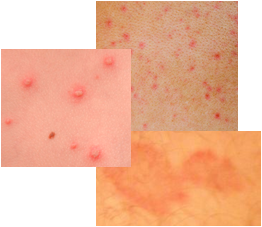Roseola Rash in Infants
Visit this
PICTURES OF RASHES PAGE
A roseola rash or roseola infantum is a very common skin rash affecting infants and younger children.
Therefore, it is commonly referred to as an infant rash or child rash. More specifically, the target age group for this skin condition is 6 months to 2 years. It may occur during the two to four year range as well, but almost never after four years of age.
Roseola Causes
The condition is caused by a virus and is considered a fairly harmless or mild illness. Actually, it is two viruses of the herpes family that cause the infant rash, although these viruses only produce the child rash and no other symptoms commonly associated with the herpes virus such as cold sores. Because it is viral, this health problem is contagious.
Roseola Symptoms
The main symptom of a roseola rash is a rosy-pink rash, usually flat but sometimes raised, that does not itch and is present on the entire body of the infant or child. This includes the face and neck areas, although the rash usually starts on the abdomen and back and then spreads to the extremities. A white ring might be present around some of the rash patches. This infant rash lasts from 24 to 48 hours on average. Another symptom that a child with roseola will experience includes the sudden appearance of a high fever (over 39.4 degrees Celsius or 103 degree Fahrenheit). This fever usually lasts for 48 to 72 hours, but can last longer. The roseola rash appears after the fever suddenly breaks. Other symptoms associated with roseola may include stomach related problems such as diarrhea or vomiting and possibly a sore throat and other symptoms that typically accompany a high fever such as lethargy and loss of appetite.
Roseola Rash Treatments
The treatment for this child rash is one of simply relieving the symptoms while the body fights off the virus. Relief includes managing the fever with acetaminophen or other non-aspirin medication to reduce fever. Lukewarm baths to cool the body temperature can also help. If the fever cannot be managed, then medical attention is required. Rest and plenty of fluids are also recommended. The actual infant rash does not need any specific treatment because it generally does not itch or produce much discomfort. Keeping the affected child comfortable and ensuring the child does not overheat usually helps to address any problems.
The rash will disappear on its own. If the roseola persists for more than a couple of days or if the child simply does not seem to be getting better after a few days, then once again contact a medical professional to discuss your child’s condition.
Visit the pictures of skin rashes page for more information.
Other viral type rashes:
shingles | chicken pox | hiv | diagnose other rashes
